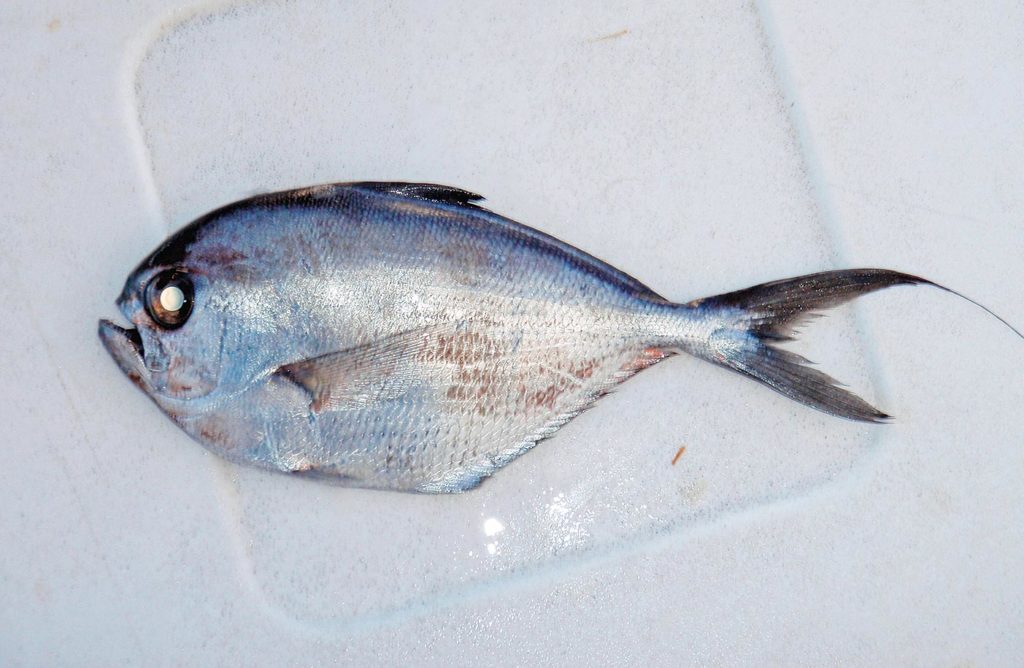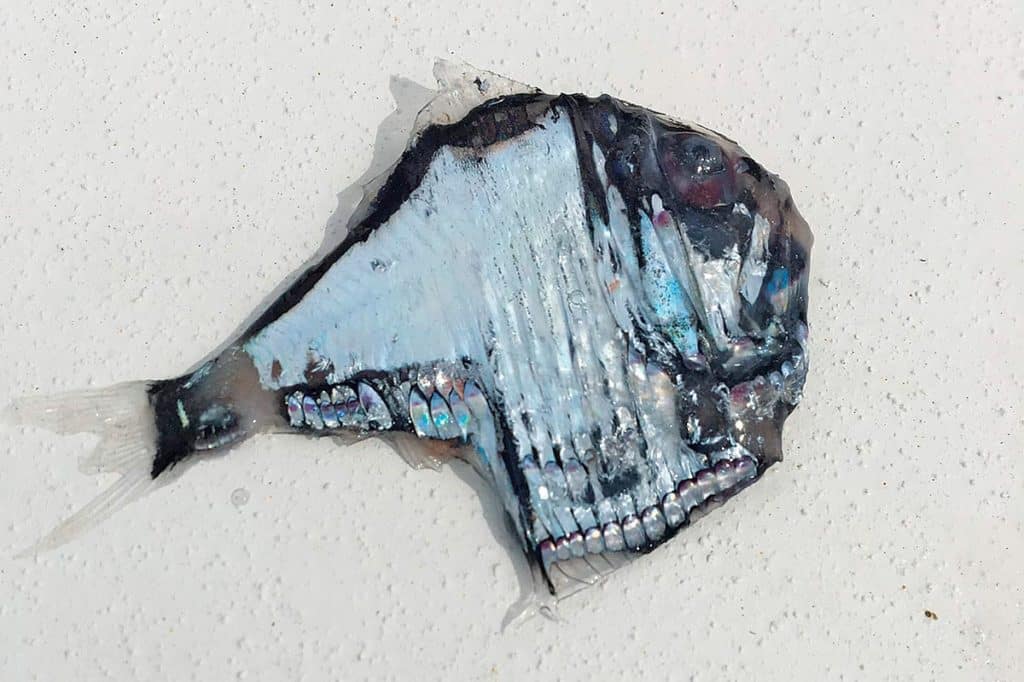A Horny Unicorny
QUESTION:
I believe this is a spotted unicornfish. Do I have the ID right? And what is the purpose of the horn?
Steve Wozniak, Alamo, California

ANSWER:
That pointy-nosed fish is indeed a spotted unicornfish, Naso brevirostris. Unicornfishes — a type of surgeonfish — are so named for the prominent rostral horn that projects from the forehead area, though not all unicornfishes have the rostral horn. Most surgeonfishes feed on benthic algae, but adult spotted unicornfish feed mainly on zooplankton, so they might interact with sport-fishing gear. The unicornfish grows to around 2 feet long and is relatively common throughout the coral reefs of the tropical Indo-Pacific from the Red Sea to Hawaii at depths of up to 300 feet. The size of the spotted unicorn’s rostral horn increases once a fish matures into an adult but, interestingly, its function remains unknown. Besides just looking weird, one could imagine it might make predators think twice about trying to consume one of these fish.
—Ben Diggles
Fret Not
QUESTION:
Off Virginia for the September white marlin bite, we drifted for swordfish while waiting for the sun to come up. We landed some of these fish while catching tinker mackerel for bait around the light. We were in about 200 fathoms. Can you tell us what we caught? (We did catch a swordfish, and the white marlin bite proved great.)
Dr. Ken Neill III, Yorktown, Virginia

ANSWER:
Ken, you caught a Caribbean pomfret, Brama caribbea. Pomfrets constitute a circumglobal group of temperate-to-tropical fishes usually found in the upper 3,000 feet of the water column. The Caribbean pomfret can be found from the surface down to nearly 2,700 feet and, in the western Atlantic, ranges from North Carolina through Brazil, including the Gulf of Mexico. Pomfrets are related to jacks (family Carangidae). Like certain jacks such as Florida pompano (Trachinotus carolinus), they’re excellent table fare and commercially fished in some areas such as the eastern Atlantic. Pomfrets vary in maximum size, depending on the species; the largest grows to approximately 3 feet, but the Caribbean pomfret reaches a maximum length of just slightly over 10 inches. Nine species of pomfrets belonging to six genera occur in the western Central Atlantic, with three of these belonging to the genus Brama. The Caribbean pomfret is very similar to the Atlantic pomfret, B. brama, but the upper lobe of its caudal fin is larger than the lower lobe.
—Ray Waldner
Hatchet Job
QUESTION:
A blackbelly rosefish that we caught while deep-dropping off South Florida coughed up this freaking cool little fish. What is it?
Twig Tolle, Miami, Florida

ANSWER:
What a great find, Twig! Your catch is a hatchetfish (family Sternoptychidae) belonging to the genus Argyropelecus, but I can’t determine the species from your photograph. The three genera and several hatchetfish species in the western Central Atlantic are similar in shape (there are also more elongated hatchetfishes belonging to other genera). All hatchetfishes have bioluminescent organs (photophores); the arrangement varies between genera and species, but they’re generally located on the lower portion of the fish’s body (visible here along the bottom of this fish as a row of small spheres or dots). The majority of hatchetfishes live in the mesopelagic zone, at depths between 660 and 3,300 feet, but some venture into the bathypelagic zone (3,300 to 13,200 feet). Their maximum length is less than 5 inches. Many are highly reflective, due to the presence of reflective guanine crystals — the same material sometimes incorporated into the coatings on hard plastic lures, such as those bearing a “G-finish.”
I never cease to be amazed by the condition of some fishes’ stomach contents. Your hatchetfish must have been consumed just a very short while before you caught the blackbelly rosefish (Helicolenus dactylopterus) that ate it. I’ve seen intact argonauts and juvenile broadbill swordfish, along with numerous sea turtles, taken from the stomachs of dolphinfish (Coryphaenus hippurus). One never knows what will be encountered when looking at the stomach contents of deep-feeding fishes!
—Ray Waldner
King of Sting
QUESTION:
This fish was caught in the Gulf of Siam near Koh Kut Island. In Thai, its name is pla baey kanoon. These fish are experts at cleaning a piece of squid from our hooks without getting caught. Once in a while we catch one, though. They’re feared by locals because of the pain they can deliver; their spines contain some bad venom. I’d like to know more about this species.
Francois Helias, Bangkok, Thailand

ANSWER:
That, Francois, is a cracker of a streaked spinefoot (Siganus javus). This species is one of the larger species of the rabbitfishes group, growing to around 20 inches long. They are found in shallow waters (mostly less than 60 feet) over coral and rocky reefs throughout the tropical Indo-Pacific from the Persian Gulf and East Africa throughout Asia to northern Australia and New Caledonia. Streaked spinefoots are relatively easy to identify with their distinctive gray background coloration overlaid with yellow highlights on the cheek and mouth, and the numerous white spots on the dorsal part of the body that graduate into irregular wavy stripes on the mid to lower sides. Like other rabbitfishes, streaked spinefoots have sharp venomous spines on the dorsal and anal fins, so they need to be handled very carefully if captured. If you should get spiked, use water as hot as you can tolerate on the wound to quickly neutralize the toxin. Many authorities consider them primarily herbivorous, feeding mainly on benthic or floating algae. However, you point out they’re known bait stealers, suggesting the fish are actually facultative omnivores that won’t turn down an easy meal. The species was named Java spinefoot when first scientifically described in 1766 (by the pre-eminent naturalist Linnaeus, no less, in his first volume of the famous Systema Naturae) from specimens collected near Java, Indonesia.
—Ben Diggles








